
A book that further explains the Irminsul. This is not offered with the tapestry, but you can read about it by entering "Irminsul" with the author's name to your favorite search engine.
|

This is the re-created tapestry that we offer; it will have fringed edges. Here is a marvelous opportunity to own such an important and esquisite artifact.
|

 ceremonies at the Extersteine. Note the bent-over Irminsul. ceremonies at the Extersteine. Note the bent-over Irminsul.
|

Entrance hall of the  -Ahnenerbe offices in Berlin. -Ahnenerbe offices in Berlin.
Here you can see the original Irminsul tapestry as it hung there.
|

Irminsul bread plate
|

| 
This symbol appears on all  -Ahnenerbe stationary. -Ahnenerbe stationary.
|

 -Standartenführer Wolfram Sievers -Standartenführer Wolfram Sievers
General Secretary of the  -Ahnenerbe -Ahnenerbe
|

Wolfram Sievers
Director of the  -Ahnenerbe -Ahnenerbe
|

Dr. Walter Darré, Racial Theoretician
The first patron of the  -Ahnenerbe -Ahnenerbe
|
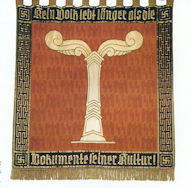
The original Ahnenerbe tapestry as found
|
|
Superb Re-creation of the Famed Ahnenerbe Tapestry with Irminsul (Item RECTAPESTRY 1-9; AHN 5-3; ART 18-2)
|
DESCRIPTION: Here we proudly present a fantastic replica of the tapestry that hung in the foyer of the Ahnenerbe-Stiftung Verlag in Berlin. This was the ancestral heritage institution that was the pet project of SS-Reichsführer Heinrich Himmler. Established by Himmler in 1935, this was an academy and society concerned with prehistory. See on our site the SS-Ahnenerbe ring and the Third Reich Ahnenerbe section AHN1-1. This was certainly the most-learned group within the National Socialist structure. Its members studied all the beginnings and ancient culture of the Teutonic people and kindred races. Among expeditions of Ahnenerbe personnel that were conducted were trips to Tibet and other far-off lands. The original tapestry was found to have been designed by professor and Oberführer-SS Karl Diebitsch and constructed by his sister Else Seifert. Much about Herr Diebitsch can be seen by going to Wikipedia and you can also go to our site and see original tapestries by Diebitsch and others by going to the Third Reich section and then to the subject SS and N.S. tapestries. Having owned the original of this tapestry we at Germania became rather enamored with it and the importance of it so we decided to commission a replica of it and that is what we presently offer. The piece came out in superlative form; the only difference, of course, is size and the copy has fringes all around the edges as it is truly an afghan in nature.
The Tapestry and the Irminsul
The words that are seen top and bottom of the tapestry are “Kein Volk lebt länger als die Dokumente seiner Kultur”–“No people live longer than the documentation of their culture.” This statement was pronounced by Adolf Hitler on the occasion of the opening of the Munich art museum Haus der Deutschen Kunst on 18 July 1937. Karl Diebitsch knew that no more fitting words could ever be more appropriate for this Ahnenerbe tapestry and for its central motif he chose the Irminsul. This was a sacred pillar-like object that played an important role in the Germanic paganism of the Saxon people. It represented the Saxon Tree of Life that held up the circumpolar stars and the immortals of the heavens—the stars that kept time for the ancients and is represented in all Caucasian tribes from the Teutons, Celts, Romans, Greeks and Egyptians. The swastika, was one of our oldest Aryan symbols. This sacred Irminsul was said to have been at the top of the Extersteine near Detmold, Germany. This is a very famous rock formation that magnificently and mysteriously juts up from the ground, and was a place of worship for the ancient Teutons. Ahnenerbe archaeologist Wilhelm Teudt in 1929, interpreted much in his studies about the connection between the Irminsul and the Extersteine. In 1934 and 1935, the SS Ahnenerbe undertook extensive fieldwork in an attempt to uncover material evidence of the use of the Extersteine as a place of pagan worship. The rocks came to have great spiritual meaning to the SS in general and many SS sponsored trips by German citizens were offered, and certain reenactments and SS ceremonies were held there. On the area considered the front of the rock formations can be seen a Christian relief carved into the rocks and dated to the early ninth century. It is a crucifixion scene. If one looks closely at Nicodemus as he helps to lift the crucified Jesus from the cross he seems to have stood on the bent Irminsul as a symbol of triumphant victory for Christianity. The artist K. Diebitsch and Wolfram Sievers, who was the managing director of the Ahnenerbe and rose to rank of SS-Standartenführer, decided to reerect the Irminsul in keeping with their immense interest in bringing the past to the present and the future. The Irminsul became the official seal of the Deutsches Ahnenerbe. The tapestry we offer is huge and measures 74 x 54 inches. It’s 100-percent American made cotton and prewashed for softness and washable in cold water. It has four different types of special stitching and threads (This is not a print on fabric!). All is woven and absolutely awe inspiring when properly displayed. By using this type of weaving there is almost a 3D effect. The colors, the quality of artwork is in a word–SUPERB! The original was sold over 20 years ago for more than $22,000.
PRICE: SOLD
|

|

Prince Josias in SS uniform
|
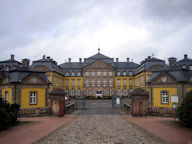
Arolsen Castle in Bad Arolsen, Hesse, Germany
|
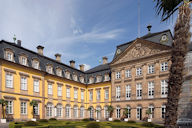
View of the Inner court of the castle
|

Star of the Arolsen crest as used today
|

Waldeck und Pyrmont Coat of Arms.
Note the Arolsen star in the center
|

Professor Karl Diebitsch at the SS Allach showrooms
|

The prince as  -Obergruppenführer (general) -Obergruppenführer (general)
|
|
Super Re-creation of the  Tapestry of SS-Obergruppenführer and Hereditary Prince Josias von Waldeck und Pyrmont (Item RECTAPESTRY 1-10; AHN 5-4; ART 18-3) Tapestry of SS-Obergruppenführer and Hereditary Prince Josias von Waldeck und Pyrmont (Item RECTAPESTRY 1-10; AHN 5-4; ART 18-3)
|
DESCRIPTION: Here is a re-creation of the tapestry that hung in the office of a royal prince of a royal German house. Prince Josias was one of the earliest members of the SS, and one of the first of the royal lines to join the ranks of the Schutzstaffel. The Erbprinz (“hereditary prince”) had an extraordinary and varied career and enjoyed an especially close relationship with Heinrich Himmler. He was born in Arolsen at the ruling family's castle, as the eldest son and heir of Prince Friedrich of Waldeck and Pyrmont, and his consort Princess Bathildis of Schaumburg-Lippe. He was the nephew of William II, King of Württemberg, and Emma of Waldeck and Pyrmont, Queen Regent of the Netherlands. He was badly wounded in WWI (including being a victim of a gas attack) and highly decorated receiving the Iron Cross First and Second Class and other decorations. He later volunteered for the Free Corps, (Freikorps) where he fought in Upper Silesia against the communists in 1919. Josias joined the Nazi Party in 1929, and the SS in 1930. He had married one of the sisters of the Hereditary Grand Duke Nikolaus of Oldenburg (1897-1970). Von Oldenburg’s two sisters married an SS major who was a prince of Schaumburg-Lippe; and SA Colonel Harald von Hedemann, making this a tight-knit circle of aristocratic NSDAP officials. During his first year in the SS, Josias became the chief of Himmler’s personal staff. Later, in 1933, he became the aide-de-camp of SS General Sepp Dietrich, who headed up Hitler’s personal security. That same year, he was promoted to major general (SS-Grüppenführer); this was part of his precipitous rise in rank. He also had a brief appointment as a counselor in the foreign office in 1933, and held a seat in the Reichstag throughout the era of the Third Reich. As of 1936, he headed the SS division of Fulda putting him in close proximity to Prince Philipp of Hessen, who was also an NSDAP royal and a high-ranking SA leader. Both Prince Josias and Prince Philipp were based in the city of Kassel. In Kassel, Josias created the Bureau for the Germanization of Eastern Peoples, which promoted the idea of SS-directed settlements in Eastern Europe. In 1939, he was appointed the higher SS and police leader in Weimar and in this capacity he had supervisory authority over the concentration camp at Buchenwald. The prince was also a general of the Ordnungspolizei (“regular police”) being personally appointed by Hitler in April 1941. Prince Josias was severe, hard driving, and ambitious. To cite an example, he oversaw an SS execution commando action at the Stadelheim Prison near Munich during the Röhm purge in June 1934, when he had to order the executions of several former comrades. It gave him no pleasure, but it was necessary to the future of the NSDAP, which he would defend with his own life, if necessary: “Wenn alle untreu werden, so bleiben wir doch true”: the  motto meaning: “If all become unfaithful, we remain loyal.” The city of Kassel was the main headquarters of the prince, but the SS-Oberabschnitt Fulda-Werra, headed by Josias, was in the town of Arolsen. The stately Arolsen Castle, which continues to serve as the family home of the former ruling family of the Principality of Waldeck and Pyrmont, is also located in Bad Arolsen. The innermost offices of Prince Josias were in the castle itself and the original of this tapestry that we offer graced the wall of his personal office in that regal castle. The symbol of the eight-pointed star—seen in different forms—is seen in the coat of arms of Arolsen; sometimes, the Waldeck arms are shown with a six-pointed star, but the prince chose to have the eight-pointed version on his personal tapestry. Note: the tapestry, like the famed Ahnenerbe example, has in its borders a series of geometric patterns that resemble a continuous pattern comprised of the letter “H” joined. Was this in honor of Heinrich Himmler? The background of the tapestry is decorated with alternating swastikas and motto meaning: “If all become unfaithful, we remain loyal.” The city of Kassel was the main headquarters of the prince, but the SS-Oberabschnitt Fulda-Werra, headed by Josias, was in the town of Arolsen. The stately Arolsen Castle, which continues to serve as the family home of the former ruling family of the Principality of Waldeck and Pyrmont, is also located in Bad Arolsen. The innermost offices of Prince Josias were in the castle itself and the original of this tapestry that we offer graced the wall of his personal office in that regal castle. The symbol of the eight-pointed star—seen in different forms—is seen in the coat of arms of Arolsen; sometimes, the Waldeck arms are shown with a six-pointed star, but the prince chose to have the eight-pointed version on his personal tapestry. Note: the tapestry, like the famed Ahnenerbe example, has in its borders a series of geometric patterns that resemble a continuous pattern comprised of the letter “H” joined. Was this in honor of Heinrich Himmler? The background of the tapestry is decorated with alternating swastikas and  runes, while the Irminsul Ahnenerbe tapestry has in it a background with alternating N.S. eagles and runes, while the Irminsul Ahnenerbe tapestry has in it a background with alternating N.S. eagles and  runics. We believe this is rather evidentiary that both of these tapestries were designed by the famed SS-Oberführer and Professor Karl Diebitsch, the originator of the SS Allach porcelain firm. More information about professor Diebitsch and the Ahnenerbe can be found at on this site here. So, dear collector, here is a chance to procure a great and accurate replica of a very important relic of the Reich. runics. We believe this is rather evidentiary that both of these tapestries were designed by the famed SS-Oberführer and Professor Karl Diebitsch, the originator of the SS Allach porcelain firm. More information about professor Diebitsch and the Ahnenerbe can be found at on this site here. So, dear collector, here is a chance to procure a great and accurate replica of a very important relic of the Reich.
PRICE: SOLD
Below are images of the SS Irminsul and the SS Arolsen tapestries
that were featured at a recent military show.
You can see the fringe that lines the edges of the pieces.
These magnificent tapestries are really limited so please act now.
Below are images of one of our tapestries on display in a customer's study.
It should be noted that
this gentleman added hanging loops to this one.

|

Note the beautiful fringe work
|

Flat, machine weave
|

Flat, machine weave
|

Possible hand weave
|

Flat, machine weave
|
 < <
|

A mixture of skillful weaving styles
|

Sturdy suspension loops
|

Appliqué–handmade
|

|
 < <
|
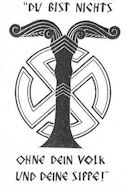
Ahnenerbe slogan with Irminsul
|

Note the revered Irminsul bent over in the Christian carving on the rocks of the Externsteine
|
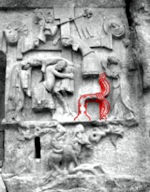
Depiction of the revered Irminsul bent over in the Christian carving on the rocks of the Externsteine
|
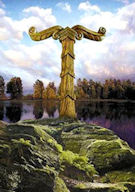
|

|

|
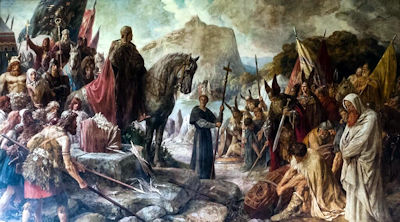
Read about the ancient Irminsul, here.
|

Large sword seen here is placed to show
viewer size perspective
|
|
Large and Accurate Re-creation of the Original Irminsul Tapestry of the  -Ahnenerbe-Stiftung (Item RECTAPESTRY 1-11; AHN 5-9) -Ahnenerbe-Stiftung (Item RECTAPESTRY 1-11; AHN 5-9)
|
DESCRIPTION: With intense study and research we have re-created the SS-Deutsches Ahnenerbe tapestry to exact specifications. This could be said to be the most famous and historically important memorial to Germany’s ancient and noble past. In the sections on this site above you will see various items and written passages concerning the Deutsches Ahnenerbe academic organization that made far-reaching inroads and intensive studies including many far-flung expeditions enabling research into Teutonic culture. Its anthropological studies marked the beginnings of the Nordic, and studies still refer to it in academia today: in other words, the rich heritage of the Germanic people. What better symbol to be the masthead or logo of this learned society than the ancient Irminsul. You can garner much information about the Ahnenerbe by going into your favorite search engine, or looking at other entries on this section of our Germania site. When there, please read between the lines and remember the victors at the end of the world conflict are given to writing the history of the war and seldom are generous to the vanquished! Why a re-creation of the  -Ahnenerbe tapestry and why did we endeavor to enter into this project? The piece is 72 x 72 inches not counting the fringe—roughly 6 ft. x 6 ft. Very impressive! This re-creation is right on as to color and design. We offer it at an extremely reasonable price because our reward was never sought to be in monetary terms, rather it was a great and distinct pleasure in adding one more manifestation of this wonderful tapestry to world history. Our advisor, Mr. Johnston, was the discoverer of the original tapestry that was sold some 25 years ago. Mind you there was only ONE original that hung in the office of the SS-Ahnenerbe in the Dahlemstrasse in Berlin. Please read the history of the IRMINSUL as well on our pages. If you are fortunate enough to procure this momentous historical article this will be evidence that one is a true “Bewegungsglauber” and not merely a accumulator of jackboots, bayonets, and field packs. This is the path of the true “Kulturträger.” -Ahnenerbe tapestry and why did we endeavor to enter into this project? The piece is 72 x 72 inches not counting the fringe—roughly 6 ft. x 6 ft. Very impressive! This re-creation is right on as to color and design. We offer it at an extremely reasonable price because our reward was never sought to be in monetary terms, rather it was a great and distinct pleasure in adding one more manifestation of this wonderful tapestry to world history. Our advisor, Mr. Johnston, was the discoverer of the original tapestry that was sold some 25 years ago. Mind you there was only ONE original that hung in the office of the SS-Ahnenerbe in the Dahlemstrasse in Berlin. Please read the history of the IRMINSUL as well on our pages. If you are fortunate enough to procure this momentous historical article this will be evidence that one is a true “Bewegungsglauber” and not merely a accumulator of jackboots, bayonets, and field packs. This is the path of the true “Kulturträger.”
PRICE: $895.00
|

Feature article on Hitler in Summer 2009 issue of Military Advisor
|

|
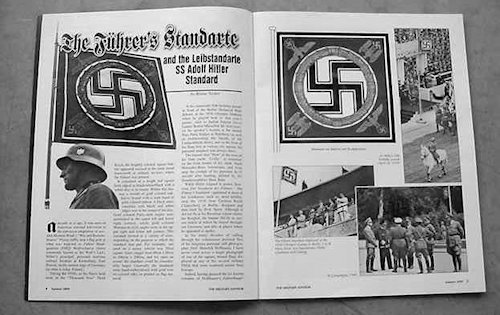
|
| 
|
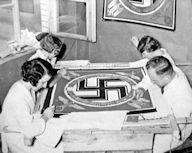
Special handling in 1938
|

Note in this period photo the two different layout schemes of the eagles in the corners.
|

|

Attending State Opera
|
|
|
Führerstandarte (Item RECTAPESTRY 1-12; SIEGFRIED TAPESTRY)
|
DESCRIPTION: This is Adolf Hitler’s personal standard re-created in the form of a fine tapestry in full, vibrant color. This was the ensign that was raised whenever the German leader was "the man of the hour" at Reich party rallies, at his massively attended birthday celebrations, riding in his limousine, or at the Olympic Stadium in 1936. When Hitler was aboard, the banner flew on his state yacht, Grille; on the front of his state box at various state and city operas; and, of course, on the majority of his residences; most notably at the top of the new German Reich Chancellery in Berlin. Oddly enough, it did not fly on the Berghof, but it did fly at various hotels on the many occasions when he patronized them during his constant early political travels. Where the Führer would be, there would be his standard! The military eagles represent him as the supreme chief of the Wehrmacht, and the political eagles represent his being the highest executive of the state and nation.
The Tapestry
As with many of our others fine tapestries, this fabulous one is a quality product made in the U.S., and the significant colors used are 100 percent like those used in the original. They are 100-percent cotton and prewashed for softness, and are washable in cold water. They are dramatic and awe inspiring, and the artwork is superb!!! (All our tapestries are limited editions.). They are quite large measuring 64 x 50 inches. Plus, there is a one-inch fringe around the four edges. When these great and wonderful wall coverings (Wandteppiche) are hung within a collection, they will make for a very special and vibrantly beautiful centerpiece. An original N.S. period tapestry of this size and quality would cost many thousands of dollars. On the advice of one of our staff members, we have decided to make a very special offer and price them at $85.00 plus shipping and any credit charges, if applicable.
SOLD
Contact teutonia@windstream.net or write to:
Germania International
P.O. Box 68
Lakemont GA 30552
Phone after 1:00 PM U.S. Eastern time 706.782.1668.
|
| 
Grimminger and Hitler with Blood Banner
|

|

|

|
|
|
Tapestry Number One; SS-Standartenführer Jakob Grimminger, 1892-1969
|
| DESCRIPTION: Jakob Grimminger was a combat hero who served with distinction in WWI, and was one of the earliest members of the Nazi Party and took an active part in the Beer Hall Putsch in Munich. He was later accorded the specific honor of being appointed the official bearer of the Blutfahne (Blood Banner) of November 9, 1923. This was a special flag carried during the unsuccessful Putsch. The flag was literally drenched in the blood of the martyrs slain on that fateful November day in 1923. It was brought to the fore by SS-Standartenführer Grimminger in numerous special rituals during the Nazi regime. During the 1930s, Jakob was a city councillor of Munich. He was one of the most respected of the "Old Fighters" and was, of course, considered one of the closest friends of the Führer, Adolf Hitler. Depicted on the tapestry that we offer you can see a bronze crucible that contained the "eternal flame." Clutched in the hands of Parteigennose (Party Member) Grimminger we see the Blood Flag. This sacred flag reposed normally in the NSDAP's Braunes Haus when not carried by Grimminger. The tapestry measures 50 x 70 inches of quality, washable, cotton weave, made in the USA with 1½-inch black and white fringes on all four sides.
PRICE: $85.00
|
|
|
|
Tapestry Number Two; The SS-Leibstandarte Adolf Hitler (LAH) on Parade
|
DESCRIPTION: This tapestry depicts the standard bearers of the SS-Leibstandarte Adolf Hitler as they lead a marching procession past the huge Nürnberg Parteitag eagle as formerly seen on the grounds of the annual Nazi Party Congress near the ancient walled city. The gabled tower-like structure in the background is part of the fortress that would not actually be seen from the party grounds, but is an add-on for artistic rendering and interesting contrast.
When the Leibstandarte-SS was redesignated SS-Sonderkommando Zossen and a new unit, SS-Sonderkommando Jüterbog was raised. These units merged September 1933 and was designated SS-Leibstandarte Adolf Hitler (LAH). The members of LAH took an oath of loyalty to Hitler on 9 November 1933 (the 10th anniversary of the failed Beer Hall Putsch). It was redesignated Leibstandarte-SS Adolf Hitler (LSSAH) in 1934.
When these men appeared, the crowd would go into a form of ecstasy personified as the sharp, black-uniformed elite guard marched by accompanied with the martial sound of the Badenweiler March.
Here is all the power and glory brought home in vivid color and super-detailed rendering. This is a background piece for any good Third Reich collection.
PRICE: SOLD OUT
|
| 
Unit insignia patch for the 3rd SS-Panzer Division "Totenkopf"
|

Reichsführer-SS Heinrich Himmler
|

August von Mackensen, leader of all the Hussars in WWI, and the hero of the Battle of Tannenberg
|

Prince August Wilhelm of Prussia, heir apparent to the Hohenzollern Dynasty
|

Princess Victoria Louise of Prussia in 1909, as Honorary Colonel of the II. Prussian Life Hussars Regiment
|
|
|
Tapestry of the  -Totenkopf "Oberbayern" (Item RECTAPESTRY 1-13; SIEGFRIED TAPESTRY) -Totenkopf "Oberbayern" (Item RECTAPESTRY 1-13; SIEGFRIED TAPESTRY)
|
| DESCRIPTION: Here we offer a splendid tapestry that commemorates the SS-Totenkopf-Standarte 1 "Oberbayern," which was formed from SS-Sturmbann Oberbayern in Dachau in 1937. During that year's Reichsparteitag, it received its Deutschland Erwache standard. The skull ("Totenkopf") is the reminder that you shall always be willing to put yourself at stake for the life of the whole community. Use of the "Totenkopf" as a military emblem began under Frederick the Great in the 1730s, who formed a regiment of Hussar cavalry in the Prussian Army. Outstanding notables who wore the "Totenkopf" symbol were August von Mackensen, Crown Prince August Wilhelm, and Heinrich Himmler. Two Sturmbanne of this unit entered the Sudetenland (Czechoslovakia) before the rest of the troops to support the Freikorps Henlein and prepare for the German occupation. It was used for "police duties" during the invasion of Poland behind the lines of the 10. Armee between Upper Silesia and the Vistula-Oder Offensive. These duties consisted of hunting down the remaining Polish soldiers and partisans. Most of the "Oberbayern" unit was used to create the "SS-Totenkopf" (3rd SS-Panzer Division "Totenkopf," an elite division of the Waffen-SS) and the remaining were used to form the SS-Totenkopf-Rekreuten-Standarte. Famous commanders of these units were SS-Oberführer Theodor Eicke, SS-Standartenführer Otto Augustini, and SS-Obersturmbannführer Max Simon. Manpower in April 1938, was only 3,335. The insignia in the cuff title was the text “Oberbayern” and was authorized for this unit and was in use until September 1938, when it was replaced by a cuff title with the "Totenkopf" symbol (the same symbol was displayed on the collar tab). Our tapestry traces the same exact lines and design as the cuff title. This magnificent tapestry is BIG measuring 70 x 54 inches. The cotton weave is excellent with two different textures for outstanding depth and dimension giving it this impressive appearance. It is made in the USA and washable. All four sides are lined with fringe in black and white colors. Wherever you place it, on a wall or used as a bedspread, this super tapestry will be a brilliant focal point to your collection.
PRICE: SOLD OUT
|
Contact Us
Please refer to item designator in parentheses in all correspondence.
Please E-mail for any additional information you may need.
If you prefer, contact 'Germania' at PO Box 68, Lakemont, GA 30552
or call at 706.782.1668 or 706.782.4398.
Please! do not call during the wee hours of the morning. The best time for calling us is between 10 am and 12 noon and between 9 and 11 pm eastern time.
| | | |

 men who had been killed in the early street fighting against the ‘Red Front’ in the 30s and to the Waffen-
men who had been killed in the early street fighting against the ‘Red Front’ in the 30s and to the Waffen- soldiers who had laid down their lives for Führer and Fatherland in the 40s (Second World War). Behind stalwart iron gates was a precious tapestry so revered that it sat behind an alter flanked by swastika flags and typical
soldiers who had laid down their lives for Führer and Fatherland in the 40s (Second World War). Behind stalwart iron gates was a precious tapestry so revered that it sat behind an alter flanked by swastika flags and typical  wall torches. Here, ceremonies were held both Christian and semi-Pagan to honor these brave men. The tapestry bore the legend “Eternal are the dead indeed." (“Ewig ist der Toten Tatenruhm”). Above this legend is the figure of a German National Eagle whose total visage is completely
wall torches. Here, ceremonies were held both Christian and semi-Pagan to honor these brave men. The tapestry bore the legend “Eternal are the dead indeed." (“Ewig ist der Toten Tatenruhm”). Above this legend is the figure of a German National Eagle whose total visage is completely  in its noble bearing. Then, all around the eagle are repetitive skulls and
in its noble bearing. Then, all around the eagle are repetitive skulls and  runes. Its borders are decorated with oak leaves and acorns in vibrant color and also there can be seen four Hagel runes and this symbol was widely used by the
runes. Its borders are decorated with oak leaves and acorns in vibrant color and also there can be seen four Hagel runes and this symbol was widely used by the  for its symbolic representation of unshakable faith in the NS-SS belief. You will also see it in the Himmler Ehrenring (Death’s-head ring) worn by members of the
for its symbolic representation of unshakable faith in the NS-SS belief. You will also see it in the Himmler Ehrenring (Death’s-head ring) worn by members of the  and also in
and also in  wedding rings. In the four corners of the tapestry are the Iron Crosses to represent the supreme valor of the departed, honorable, fighting men. Nothing could have been considered more sacred than this tapestry other than the Blutfahne (Blood Flag) as carried in the Munich Putsch. Where this original tapestry is today no one knows among the collectors and researchers. I personally hope it was hidden away in time to save it from the ravages and destruction brought to Germany by the “glorious” Allied enemy.
wedding rings. In the four corners of the tapestry are the Iron Crosses to represent the supreme valor of the departed, honorable, fighting men. Nothing could have been considered more sacred than this tapestry other than the Blutfahne (Blood Flag) as carried in the Munich Putsch. Where this original tapestry is today no one knows among the collectors and researchers. I personally hope it was hidden away in time to save it from the ravages and destruction brought to Germany by the “glorious” Allied enemy. having designed many of the
having designed many of the  uniforms,
uniforms,  daggers, and sword crests for
daggers, and sword crests for  officers, postage stamps with the
officers, postage stamps with the  theme, and several other important tapestries such as this one. We also present to you an actual rare prototype model 36 chained
theme, and several other important tapestries such as this one. We also present to you an actual rare prototype model 36 chained  officer’s dagger by the professor on our pages at SS 36-14 You should go there for further information about Herr Diebitsch. Also see SS 36-15 to see another of his beautiful tapestry creations. His sister, Elsie Seifert, had early moved to America, but went back to Germany when Karl summoned her shortly after he was commissioned by the Reichsführer-
officer’s dagger by the professor on our pages at SS 36-14 You should go there for further information about Herr Diebitsch. Also see SS 36-15 to see another of his beautiful tapestry creations. His sister, Elsie Seifert, had early moved to America, but went back to Germany when Karl summoned her shortly after he was commissioned by the Reichsführer- Himmler to create several important tapestries for the Reich. She was the artist who did the actual construction, while her brother was the designer. Mr. R. Johnston, our historical advisor, met both Professor Diebitsch and Frau Seifert in the early 1980s and interviewed both of them. Although of advanced age, he found them to be sharp, informative, and more than willing to tell of their beloved art. They both gave Mr. Johnston several pictures of tapestries and other art pieces they had accomplished while in
Himmler to create several important tapestries for the Reich. She was the artist who did the actual construction, while her brother was the designer. Mr. R. Johnston, our historical advisor, met both Professor Diebitsch and Frau Seifert in the early 1980s and interviewed both of them. Although of advanced age, he found them to be sharp, informative, and more than willing to tell of their beloved art. They both gave Mr. Johnston several pictures of tapestries and other art pieces they had accomplished while in  employ, and this included the pictures of the
employ, and this included the pictures of the  memorial tapestry in its place of honor at Dachau. Frau Seifert gave him pictures of many other tapestries they had created in the 30s and 40s, but the one that impressed him (Johnston) most was the Dachau Memorial Tapestry and when he saw these pictures that we show here, he said immediately that this masterpiece wall hanging just had to be created once again because it is so very meaningful. So, out of the pages of N.S.-SS history it comes forth once more and it is carefully and colorfully re-created. There is very little perceptible difference except for the fringe, but that couldn’t be helped. The workmanship is so very good that another tapestry made by the same company ended up being offered for $3,500 in a major European auction house whose staff thought it was authentic and from the N.S. “Braun Haus” in Munich, but when Mr. Johnston told them the facts it was withdrawn—these tapestries are really that fine. This re-creation is BIG: 68 x 50 inches.The colors are fast and they are washable. All in all, Mr. Johnston considers them to be a masterpiece of the weaver’s machine art. Here is your chance to own what can be considered a fitting tribute to true beauty perceived in cloth and dedicated to the hope of no more terrible ‘brother wars.’
memorial tapestry in its place of honor at Dachau. Frau Seifert gave him pictures of many other tapestries they had created in the 30s and 40s, but the one that impressed him (Johnston) most was the Dachau Memorial Tapestry and when he saw these pictures that we show here, he said immediately that this masterpiece wall hanging just had to be created once again because it is so very meaningful. So, out of the pages of N.S.-SS history it comes forth once more and it is carefully and colorfully re-created. There is very little perceptible difference except for the fringe, but that couldn’t be helped. The workmanship is so very good that another tapestry made by the same company ended up being offered for $3,500 in a major European auction house whose staff thought it was authentic and from the N.S. “Braun Haus” in Munich, but when Mr. Johnston told them the facts it was withdrawn—these tapestries are really that fine. This re-creation is BIG: 68 x 50 inches.The colors are fast and they are washable. All in all, Mr. Johnston considers them to be a masterpiece of the weaver’s machine art. Here is your chance to own what can be considered a fitting tribute to true beauty perceived in cloth and dedicated to the hope of no more terrible ‘brother wars.’